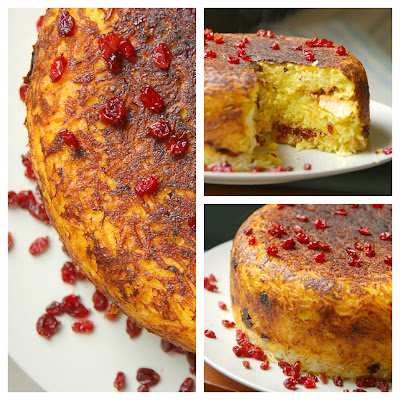No-Bake Tah-chin e Morgh (Persian Upside Down Layered Saffron Rice & Chicken Casserole)
 |
Persian cuisine is one of the least advertised among its other middle-eastern competitors. I've always wondered why that is. I even have some theories, but I have to say that whatever the reason, it's really a bit of shame that there's not more of it out there! The food may generally be a bit heavy as I mentioned in the last post, but it doesn't take much for a home cook to turn all the delicious (and very fragrant) stews into healthy dishes for everyday consumption.
One thing that many people who have a limited exposure to Persian food say is that some of the dishes look like cakes; usually they're talking about rice and the many different kinds of pilaf. The idea for this last weekend's dish also came from a random conversation I had with a Malaysia-based couchsurfer from Poland at my university (in Hong Kong--globalization, eat my heart out!). While eating her slice of watermelon, she quite fiercely tried to remember the name of some food her Persian flatmate had made the other day: "It's an inverted cake, you know... with saffron, and chicken, and a thick... thick and almost burnt crust." And I had to think: Tahchin Morgh this weekend, it is!
Anyway, the whole week I was thinking about the term "cake" that she used. It made me giggle for some reason hehe. I myself have only known the dish by its original name, but by doing a bit of recipe hunting, I realized that many people also call it pudding, casserole, and a whole bunch of random names. They're all different perspectives for looking at the same dish!
Many people make this layered cake without barberries (sacrilege!), but I thought it might also go well with the chicken and saffron, so I added it; and I was right! How could I not be when the same combination is fabulous in Zereshk Polo ba Morgh (Chicken and Barberry Pilaf)! And well, since barberries are part of the signature of this blog, I have an excuse to douse my food with them (ha!). Anywho, I'm very proud that my "cake" came out of the pot as it was supposed to, in one piece with all the layers firmly adhered together. Given another chance though, I'd have lessened the final cooking time to 20 minutes as I think the longer cooking time just evaporates the water in yoghurt and makes the food become a bit dry.
Ingredients (Serves 2-3)
1½ cups basmati rice, washed and soaked for 30 mins
½ lb chicken breast, cut into 1" stripes
1 medium onion, cut into 6-8 pieces
1 tbsp turmeric
½ tsp saffron, ground and soaked in 1 tbsp boiling water
1 carton yoghurt
1 egg
1 egg yolk
1 cup dried barberries, washed (optional)
2 tbsp extra virgin olive oil (2 tsp for barberries optional)
1 tbsp sugar, dissolved in 2 tbsp hot water (only for barberries; optional)
Salt and pepper to taste
- Parboil the rice with 4 cups of water for about 15 minutes. Drain water and reserve rice.
- Meanwhile, in a saucepan, combine the chicken, onion, turmeric, and salt and pepper to taste. Add 3 cups of water and simmer for around 30 minutes.
- Remove chicken from broth. Reserve both chicken and broth separately.
- In a bowl, whisk together the yoghurt, eggs, and saffron water, so that the mixture becomes a bright sunshine yellow.
- Back in the pan, fry the barberries with olive oil on low heat for less than a minute. Pour in the sugar syrup and stir for another minute or two. Drain excess water and reserve barberries.
- Tah-chin is a layered cake, so to form the layers, start by heating 1 tbsp olive oil in a nonstick saucepan on low heat. Pour in 1 ladle of the yoghurt mixture, followed by a thin layer of rice. Cover this layer with another layer of the yoghurt mixture, then some barberries, chicken, yoghurt mixture, rice, and so on until you've used up all your ingredients. End by pouring a few tablespoons of the turmeric-scented chicken broth on the rice and sealing the cake with a final layer of the yoghurt mix.
- Cover the pan with its lid wrapped in a towel. Cook on low heat for about 30 minutes.
- Remove from heat. Cool down the sides of the pan with cold running water. This will help the rice cake to shrink a bit more so that it can slide right out of the pan.
- To serve, place the serving plate, face down, on top of the pan. Flip the pan up-side down with the plate still held in place tightly. Carefully lift the pan to reveal a gorgeous layer of crisp rice encasing the soft interior. If done right, the cake should be sitting on the plate intact! Sprinkle with some more barberries, or a garnish of your liking, and you're done!




